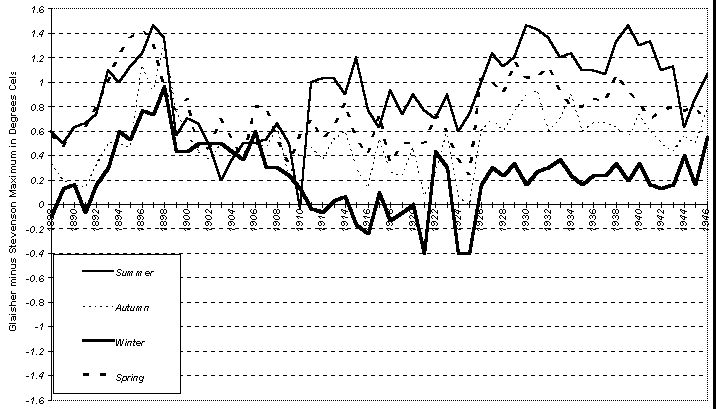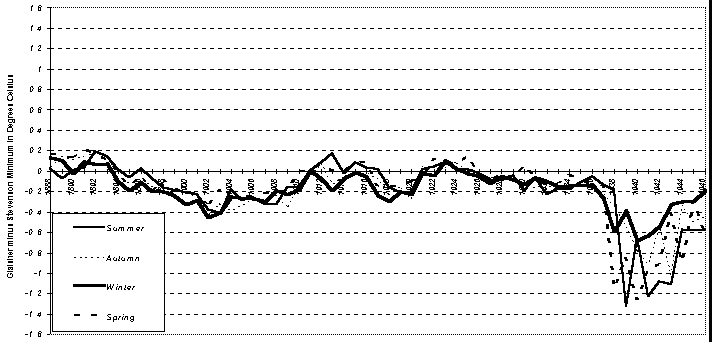Comment on -
"Historical
Thermometer Exposures in Australia"
(by N. Nicholls, R. Tapp, K. Burrows and D.
Richards)
by
Warwick S. Hughes
Tasman Institute, Melbourne, Australia.
![]() KEY
WORDS : Australia, Adelaide, Glaisher stand, Stevenson screen, Climate
Change.
KEY
WORDS : Australia, Adelaide, Glaisher stand, Stevenson screen, Climate
Change.
ABSTRACT
![]() This
short note presents seasonal time series for the 1888-1946 period of an
Adelaide experiment comparing Glaisher stand and Stevenson screen temperature
data examined by Nicholls et al (1996). Site changes and a station move
for the Adelaide experiment may account for discontinuities in the seasonal
trends which make the data unrepresentative as a test of comparative thermometer
exposure. Research directions are suggested that might cast light on these
problems in the data.
This
short note presents seasonal time series for the 1888-1946 period of an
Adelaide experiment comparing Glaisher stand and Stevenson screen temperature
data examined by Nicholls et al (1996). Site changes and a station move
for the Adelaide experiment may account for discontinuities in the seasonal
trends which make the data unrepresentative as a test of comparative thermometer
exposure. Research directions are suggested that might cast light on these
problems in the data.
INTRODUCTION
![]() Nicholls
et al (1996) have brought to light records pertaining to meteorological
equipment from colonial times for Western Australia, Queensland and South
Australia.
Nicholls
et al (1996) have brought to light records pertaining to meteorological
equipment from colonial times for Western Australia, Queensland and South
Australia.
![]() Nicholls
et al give a brief account of the 1887-1948 experiment comparing temperatures
measured in a Glaisher stand against those from a Stevenson screen and
conclude that, "Over the year,
the mean temperatures were about 0.2°C warmer in the Glaisher stand,
relative to the Stevenson screen." For their source
data they rely on two unpublished reports, Richards et al (1992 and 1993),
which are essentially records of numerous statistical exercises carried
out on the Glaisher / Stevenson data by students at Swinburne University
of Technology in Melbourne. These reports do not contain an adequate analysis
of the possible causes of significant discontinuities in the time series
despite Richards et al (1993) containing a summary detailing at least six
screen changes and a station move, events which in most cases correspond
with discontinuities in the temperature data.
Nicholls
et al give a brief account of the 1887-1948 experiment comparing temperatures
measured in a Glaisher stand against those from a Stevenson screen and
conclude that, "Over the year,
the mean temperatures were about 0.2°C warmer in the Glaisher stand,
relative to the Stevenson screen." For their source
data they rely on two unpublished reports, Richards et al (1992 and 1993),
which are essentially records of numerous statistical exercises carried
out on the Glaisher / Stevenson data by students at Swinburne University
of Technology in Melbourne. These reports do not contain an adequate analysis
of the possible causes of significant discontinuities in the time series
despite Richards et al (1993) containing a summary detailing at least six
screen changes and a station move, events which in most cases correspond
with discontinuities in the temperature data.
![]() It
is this writer’s view that the Richards et al (1992 and 1993) reports are
not adequate supporting references under the circumstances and that Nicholls
et al (1996) should have submitted their data for review as a new project.
It
is this writer’s view that the Richards et al (1992 and 1993) reports are
not adequate supporting references under the circumstances and that Nicholls
et al (1996) should have submitted their data for review as a new project.
ADELAIDE THERMOMETER EXPOSURE EXPERIMENT
![]() The
experiment commenced in 1887 and records exist for the dual exposures until
1948, which leads Nicholls et al (1996) to make the point that "This
period of comparison far exceeds other comparisons between stands and screens,
as reported in Parker (1994)." Perhaps the long
period of this comparison is less of an advantage given the numerous site
and equipment changes. Could it be more likely that interest in the experiment
only lasted a decade or so and then it simply "ran on" because
nobody took a decision to cease the dual readings? It is thus possible
that factors such as differential equipment deterioration could have set
in causing some of the trends seen in the difference time series. Nicholls
et al (1996) present no time series showing trends over the 61 year period
and make no mention of equipment changes or site variations.
The
experiment commenced in 1887 and records exist for the dual exposures until
1948, which leads Nicholls et al (1996) to make the point that "This
period of comparison far exceeds other comparisons between stands and screens,
as reported in Parker (1994)." Perhaps the long
period of this comparison is less of an advantage given the numerous site
and equipment changes. Could it be more likely that interest in the experiment
only lasted a decade or so and then it simply "ran on" because
nobody took a decision to cease the dual readings? It is thus possible
that factors such as differential equipment deterioration could have set
in causing some of the trends seen in the difference time series. Nicholls
et al (1996) present no time series showing trends over the 61 year period
and make no mention of equipment changes or site variations.
![]() Richards
et al (1993), in Appendix 5 records a four page summary of station history
supplied by Dr. N. Nicholls and compiled from BoM records and archives,
which details as best as the old records will permit, at least six screen
changes over the period with at times more than two sets of instruments
recording concurrently and a site change to new offices in 1944. In this
summary the old style thermometer enclosure is referred to as a "Greenwich
stand". Richards (1993), on page 14 refers to the four page summary
as "...vague and ambiguous,
and did not make clear when and where equipment was moved."
Climatologists who have researched century old records would not be surprised
at this. However, readers of Nicholls et al (1996) get no hint of the inhomogeneities
related to these site changes that can be seen in both the maxima and minima
difference seasonal time series shown below.
Richards
et al (1993), in Appendix 5 records a four page summary of station history
supplied by Dr. N. Nicholls and compiled from BoM records and archives,
which details as best as the old records will permit, at least six screen
changes over the period with at times more than two sets of instruments
recording concurrently and a site change to new offices in 1944. In this
summary the old style thermometer enclosure is referred to as a "Greenwich
stand". Richards (1993), on page 14 refers to the four page summary
as "...vague and ambiguous,
and did not make clear when and where equipment was moved."
Climatologists who have researched century old records would not be surprised
at this. However, readers of Nicholls et al (1996) get no hint of the inhomogeneities
related to these site changes that can be seen in both the maxima and minima
difference seasonal time series shown below.

Fig. 1: Adelaide, Glaisher minus Stevenson Maximum for the Four Seasons
![]() The
maxima graph shown in Fig. 1, reveals discontinuities in the data at the
time of four of the instrument changes, which might have been enough to
impress the Richards et al (1993) team that external non-climatic forces
were impacting on their data at specific times. In particular the 1898,
1910, 1925, 1938-39 and 1944 site changes appear to be reflected in abrupt
changes in the course of the some of the seasonal traces. However Richards
et al (1993) concluded that the variations in monthly maximum differences
could "...be seen as randomly
scattered."
The
maxima graph shown in Fig. 1, reveals discontinuities in the data at the
time of four of the instrument changes, which might have been enough to
impress the Richards et al (1993) team that external non-climatic forces
were impacting on their data at specific times. In particular the 1898,
1910, 1925, 1938-39 and 1944 site changes appear to be reflected in abrupt
changes in the course of the some of the seasonal traces. However Richards
et al (1993) concluded that the variations in monthly maximum differences
could "...be seen as randomly
scattered."

Fig. 2: Adelaide, Glaisher minus Stevenson Minimum for the Four Seasons
![]() In
the case of the minima differences, Richards et al (1993) are able to draw
attention to the gross aberration in the traces circa 1937-47 which as
they point out is due to a drastic decline in the Glaisher readings from
August 1938 and relate this to "...some
unknown influence...".
In
the case of the minima differences, Richards et al (1993) are able to draw
attention to the gross aberration in the traces circa 1937-47 which as
they point out is due to a drastic decline in the Glaisher readings from
August 1938 and relate this to "...some
unknown influence...".
CONCLUSIONS
![]() Nicholls
et al (1996) have not presented the data and associated historical records
that would be required to support valid conclusions as to the Glaisher
/ Stevenson difference revealed by the Adelaide experiment. The onus is
on Nicholls et al to do more with this data and related records if their
findings are to be considered along with those of Parker (1994). At the
very least there is a need to compare these data to other temperature records
from the Observatory as well as records from other sites.
Nicholls
et al (1996) have not presented the data and associated historical records
that would be required to support valid conclusions as to the Glaisher
/ Stevenson difference revealed by the Adelaide experiment. The onus is
on Nicholls et al to do more with this data and related records if their
findings are to be considered along with those of Parker (1994). At the
very least there is a need to compare these data to other temperature records
from the Observatory as well as records from other sites.
REFERENCES
Hughes,W.S., 1995. Comment on D.E.Parker, ‘Effects of Changing Exposure of Thermometers at Land Stations", Int. J. Climatology, 15, 231-234.
Nicholls,N., R.Tapp, K.Burrows and D.Richards, 1996. Historical Thermometer Exposures in Australia. Int. J. Climatology, In Press.
Parker,D.E. 1994. ‘Effects of Changing Exposure of Thermometers at Land Stations’, Int. J. Climtology, 14, 1-31.
Richards, D., G.Wilson, K.Sheng How, S.Kang, A.Tan and S.Chueng, 1992. Comparison of Temperature Measures. Report for Bureau of Meteorology Research Centre, Swinburne University of Technology, November 1992, 176 pp.
Richards,D., G.Nind, K.Ramchand and P.Keyhoe, 1993. Differences in Temperature Recordings between the Glaisher Stand and Stevenson Screen. Report for Bureau of Meteorology Research Centre, Swinburne University of Technology, October 1993, 123 pp.
![]()
Response
from Neville Nicholls
Australian Bureau Of Meteorology
(Received
19-May-97)
![]() The
extra detail Warwick Hughes
provides on the Adelaide comparisons of thermometer exposure confirms the
conclusions of Nicholls et al.
(1996). Warwick's figures show that mean temperatures in the Glaisher stand
are biased relative to the modern Stevenson Screen. So, as noted in Nicholls
et al. (1996), 19th century temperatures, which were often measured with
open exposures such as Glaisher stand, are biased warm relative to 20th
century temperatures.
The
extra detail Warwick Hughes
provides on the Adelaide comparisons of thermometer exposure confirms the
conclusions of Nicholls et al.
(1996). Warwick's figures show that mean temperatures in the Glaisher stand
are biased relative to the modern Stevenson Screen. So, as noted in Nicholls
et al. (1996), 19th century temperatures, which were often measured with
open exposures such as Glaisher stand, are biased warm relative to 20th
century temperatures.
![]()
Return to "Still Waiting For Greenhouse"